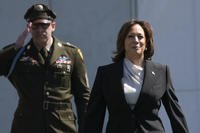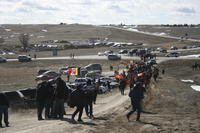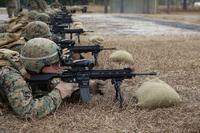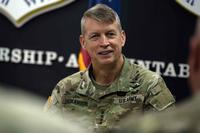In a major reversal of Obama administration policy, President Donald Trump has given Defense Secretary Jim Mattis broad authority to set troop levels in Iraq and Syria, according to the Pentagon.
The number of troops deployed, the so-called "Force Management Levels," was the closely held prerogative of the White House under former President Obama. But in a statement Thursday night, the Pentagon said, "The president has delegated authority to the secretary of defense to determine force management levels (FML) for Iraq and Syria."
The change, first reported by BuzzFeed's Nancy Youssef, should not be interpreted to mean that Mattis is abandoning Obama's overall strategy to avoid boots-on-the-ground combat and focus on training, advising and equipping local partners, the statement continued.
"Our strategy remains to work by, with and through local forces," it said.
In addition, Mattis has made no decision to boost the number of U.S. troops in Iraq and Syria. "No change to current authorized force levels has been made," according to the statement.
Currently, about 500 mostly Special Forces troops are permitted in Syria and a little more than 5,000 in Iraq under the existing Force Management Levels. However, the actual number of troops on the ground has consistently exceeded those limits by the addition of troops deployed on a "temporary" basis.
Last month, several hundred Marines from the 11th Marine Expeditionary Unit were sent into northeastern Syria to set up a firebase for M777 .155mm howitzers to support the drive by the U.S.-backed Syrian Democratic Forces on Raqqa, the so-called capital of the Islamic State of Iraq and Syria. A small contingent of Army Rangers and Stryker combat vehicles also moved into Manbij in northeastern Syria.
Also last month, the Defense Department announced that an additional 2,500 troops, including troops of the 82nd Airborne Division's 2nd Brigade Combat Team based at Fort Bragg, North Carolina, were being sent to Kuwait, where they would be on standby for possible deployment to either Iraq or Syria to support local forces against ISIS.
Mattis has made clear since his Senate confirmation hearings that he is looking for ways to accelerate the campaign against ISIS, which could include scrapping the Obama administration's caps on the number of U.S. troops in Iraq and Syria.
The question remains whether Mattis also now has authority to deploy more troops in other areas. Army Gen. John Nicholson, commander of U.S. Forces-Afghanistan and NATO's Resolute Support mission, has requested a "few thousand" more U.S. troops to counter the deteriorating security situation in Afghanistan.
House Armed Services Committee Chairman Rep. Mac Thornberry, a Texas Republican, has also called for the deployment of more U.S. troops to South Korea to guard against the North Korean threat. "We must increase our military presence and capability in the region," he said at a House hearing Wednesday.
The decision by Trump to delegate more authority to Mattis followed complaints by three defense secretaries who served under Obama -- Robert Gates, Leon Panetta and Chuck Hagel -- about being "micromanaged" by White House officials on military matters.
-- Richard Sisk can be reached at Richard.Sisk@Military.com.




























